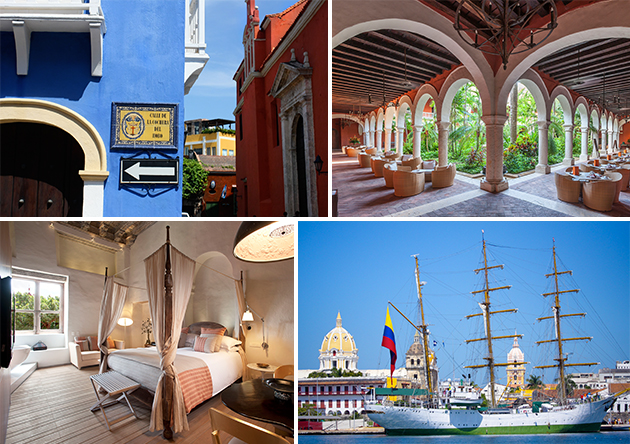
The colonial city of Cartagena is one of those places you will never want to leave. The picturesque cobbled streets are lined with multicolored houses with wooden balconies and dripping with blossoms. Every other building seems to be a bar, café or boutique, and wide, leafy plazas provide shade from the Caribbean sun. The reasons to visit this Colombian city are countless, but here are three to get you started:
1. Food. If the mere thought of fresh seafood doesn’t whet your appetite, then the mouthwatering smells drifting from the pan de queso (cheese bread) bakeries, restaurants and cafés in this walled city will set your stomach rumbling. There’s a complete range of eateries: from street vendors with stalls stacked high with tropical fruits (including mango, papaya, granadilla and guava) to casual restaurants like La Cevicheria and fine-dining spots like VERA, where you can eat local pasta, salad and fresh fish dishes.
2. Hotels. VERA is actually a part of a hotel, the boutique Tcherassi Hotel and Spa owned by Colombian fashion designer Silvia Tcherassi. The seven bedrooms were designed by Silvia and have original stonewalls and balconies so you can enjoy city or garden views. The grande dame of hotels, however, is Sofitel Legend Santa Clara, a former 17th-century convent. Based around a lush courtyard, this charming property has 122 bedrooms, including the Fernando Botero Suite designed by the famed Colombian artist’s daughter. It’s filled with his works of art. Plus, there’s a great fine-dining restaurant, 1621, where you will be attended to by the city’s only hotel sommelier, Oscar Santos.
3. History. There’s an interesting story behind the name of Cartagena. In full, the city is known as Cartagena de Indias. When the Spanish arrived in the 16th century, they believed they had reached the shores of India. Therefore, they called the locals “Indians.” By the time they realized they had landed in the Americas, the name had stuck, and so it remains today. As with all Spanish colonies, there are several convents, not least the Convent of La Popa, which was built at the turn of the 17th century and sits high on a hill above the city. Then there’s Felipe Fort, erected in the late 1700s under Spanish order by the usage of slave labor. History follows you wherever you turn as you explore the worn streets — even the emerald market, Las Bóvedas, was originally built in the 1790s and served for many years as the city’s dungeons.
Photos courtesy of Sofitel Luxury Hotels

